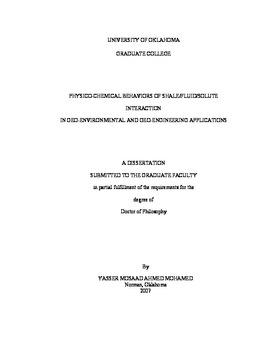| dc.contributor.advisor | Forgotson, James M., | en_US |
| dc.contributor.advisor | Dewers, Thomas A., | en_US |
| dc.contributor.author | Mohamed, Yasser Mosaad Ahmed. | en_US |
| dc.date.accessioned | 2013-08-16T12:20:37Z | |
| dc.date.available | 2013-08-16T12:20:37Z | |
| dc.date.issued | 2007 | en_US |
| dc.identifier.uri | https://hdl.handle.net/11244/1178 | |
| dc.description.abstract | This dissertation examines the rich and complex physical-mechanical behaviors exhibited by shales when exposed to differing solutions over time, temperature, chemical, and stress conditions. Using several unique experimental designs and numerical modeling, this study advances the level of understanding of time dependent shale behavior arising from changes in clay mineral structure and crystalline phase. | en_US |
| dc.description.abstract | The flux of water and ions over time due to semi-permeable membrane properties of shale and very fine-grained material has been numerically modeled. The purposes of this model are to predict the flux of fluid and ions through natural geological fine-grained and clay-rich materials over time and to predict the effect of this flux on long-term shale membrane behaviors. The required input parameters for the model, including water activity of both interfacial chemical fluid and the pore-fluid of the membrane, membrane properties (reflection coefficient, porosity, hydraulic conductivity, mineral compressibility, diffusion processes), and temperature and pressure conditions, were determined by laboratory work on Pierre Shale using High-Temperature High-Pressure (HTHP) Shale Apparatus. Results of this model reveal that, due to the flux of solute through the semi-permeable membrane, the shale's pore fluid activity will reduce through time, leading to a reduction in the ideality of the membrane. Given enough time (depending on the activity of the chemical used and the membrane thickness and permeability), the chemical and hydraulic difference across the membrane will disappear, leading to a diminishing of the osmotic fluid flux. This model can help in correlating and representing the semi-permeable membrane behavior of fine-grained and clay-rocks, and enhance understanding of the relevant processes. The implications for geo-environmental exploitation of the membrane properties of shales are discussed in light of these results. (Abstract shortened by UMI.) | en_US |
| dc.description.abstract | Artificial dewatering of shales is a method to eliminate shale related problems such as wellbore stability, swelling, and soil instability that produces landslides. In this dissertation, the semi-permeable membrane behavior of shale, permitting osmotic flux of fluid to the partial exclusion of ions, has been studied as a means to dewater shales exposed to chemical solutions with ion activities less than that of the in situ shale pore fluid. | en_US |
| dc.format.extent | xx, 201 leaves : | en_US |
| dc.subject | Geology. | en_US |
| dc.subject | Oil well drilling. | en_US |
| dc.subject | Engineering, Environmental. | en_US |
| dc.subject | Engineering, Petroleum. | en_US |
| dc.subject | Shale. | en_US |
| dc.subject | Boring. | en_US |
| dc.title | Physico-chemical behaviors of shale/fluid/solute interaction in geo-environmental and geo-engineering applications. | en_US |
| dc.type | Thesis | en_US |
| dc.thesis.degree | Ph.D. | en_US |
| dc.thesis.degreeDiscipline | Conoco Phillips School of Geology and Geophysics | en_US |
| dc.note | Advisers: Thomas A. Dewers; James M. Forgotson. | en_US |
| dc.note | Source: Dissertation Abstracts International, Volume: 68-04, Section: B, page: 2195. | en_US |
| ou.identifier | (UMI)AAI3261101 | en_US |
| ou.group | Mewbourne College of Earth and Energy::Conoco Phillips School of Geology and Geophysics | |
